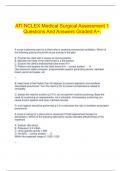ATI NCLEX Medical Surgical Assessment 1
Questions And Answers Graded A+.
A nurse is planning care for a client who is receiving mechanical ventilation. Which of
the following actions should the nurse include in the plan
A. Provide the client with a means of communication
B. Maintain the head of the client's bed in a flat position
C. Suction the client's endotracheal tube every 4 hr
D. Perform oral hygiene for the client every 8 hr - correct answer. A
Use electronic tablet computer, programmable speech generating device, alphabet
board, pencil and paper, etc
--
B, keep head of bed higher than 30 degrees to prevent aspiration and ventilator
associated pneumonia. Turn the client q 2hr to prevent complications related to
immobility
C, assess the need to suction q 2-4 hr, but not perform routine suctioning. Base the
need for suctioning on assessments, not a schedule. Unnecessary suctioning can
cause bronco spasms and injury tracheal mucosa
D, oral hygiene should be performed q 2 hr to decrease the risk of ventilator associated
pneumonia
A nurse is caring for a client who is receiving IV fluid replacement therapy for
dehydration. Which of the following laboratory results indicates effectiveness of the
treatment
A. Sodium 165 mEq/L
B. Potassium 5.2 mEq/L
C. Urine specific gravity 1.020
D. Hct 62% - correct answer. C
Within the expected range of 1.005-1.030
--
,A, sodium range is 136-145
B, potassium range is 3.5-5
D, Hct range is 37%-52%
A nurse is monitoring the laboratory findings for a client who is postoperative following a
total hip arthroplasty 6 hr ago. Which of the following values indicates that the client has
an increased risk for bleeding
A. PT 11.5 seconds
B. aPTT 35 seconds
C. Platelets 80,000
D. RBC 4.0 million - correct answer. C
platelet range is 150,000-400,000
--
A, PT range is 11-12.5
B, aPTT range is 30-40 seconds
D, RBC range is 4.2-6.1 million. A low RBC can indicate that bleeding has occurred, but
it does not indicate that the client is at risk for bleeding
A nurse is admitting a client who has a cervical spinal cord injury following a motor
vehicle crash. Which of the following interventions is the nurse's priority while caring for
this client
A. Change the client's position every 2 hours
B. Pad pressure points at the edges of the client's cervical collar
C. Palpate the client's abdomen for bladder distention
D. Assist the client with quad coughing - correct answer. D
The greatest risk to a client who has a cervical spinal cord injury is an obstructed
airway; the priority is to ensure the client can clear their airway. Apply abdominal
pressure as the client coughs (quad coughing)
A nurse is caring for a client who is receiving a blood transfusion. Which of the following
findings indicates that the client is experiencing transfusion-associated circulatory
overload
A. Nasuea
B. Hypothermia
C. Dyspnea
D. Bradycardia - correct answer. C
Dyspnea is an indication of possible transfusion associated circulatory overload, leading
to hypertension, bounding pulses, and confusion. Dyspnea can also indicate transfusion
, related acute lung injury to an anaphylactic response, which also causes wheezing,
chest tightness, cyanosis, and low BP
--
A, nausea can indicate an acute hemolytic transfusion reaction
B, transfusion reactions include acute hemolytic, febrile, mild allergic, and anaphylactic
D, bradycardia is not an indication
A nurse is assessing a client who has lung cancer and is undergoing radiation therapy
to the chest. Which of the following indicates an adverse effect of the therapy
A. Hair loss on the scalp
B. Sweating at the treatment site
C. Altered taste sensations
D. Intolerance to cold - correct answer. C
Altered taste is a result of the release of metabolites by dead cells
--
A, client may have hair loss at the treatment site on the chest
B, client might have skin changes, such as dryness and increased sensitivity
D, avoid heat exposure
A nurse is preparing to administer a unit of packed RBCs to a client who has anemia.
Which of the following actions should the nurse plan to take (select all that apply)
A. Obtain pre-transfusion temperature
B. Prime the IV tubing with lactated Ringer's
C. Instruct an assistive personnel to monitor the client during the transfusion
D. Verify the client's blood type with a second nurse
E. Use a 20 gauge IV needle for venous access - correct answer. A, D, E
--
A, complete assessment prior to transfusion
B, prime tubing with a solution that does not cause hemolysis of PRBCs. No LR or 5%
dextrose!
C, nurse should remain with pt for first 15 minutes of transfusion
D, verify identification, blood compatibility, and expiration of product with second nurse




